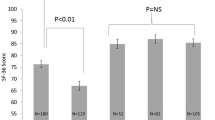Abstract
Purpose
To determine the effects of repair technique and hernia recurrence on patient-reported outcomes after incisional hernia repair.
Methods
This cohort study included patients from sixteen Veteran’s Affairs Medical Centers across the United States who underwent elective incisional hernia repair between 1997 and 2002. Technical details and outcomes (repair type and recurrence status) were determined by physician chart review. Patient satisfaction, chronic pain (McGill pain scale and visual analogue scale), and health-related quality of life (Short Form 36) were evaluated with a mailed survey at a median of five years after repair. Multivariable regression modeling was performed to evaluate the effect of repair type and recurrence status on patient-reported outcomes.
Results
Of 854 patients alive at the time of survey mailing, 371 responded (43.4%). Patients with active recurrence were more likely to be dissatisfied with their results (odds ratio (OR) 6.2, P < 0.0001), to have chronic sensory hernia site pain (OR 3.2, P = 0.01), to report disturbance from pain (OR 2.1, P = 0.04), and to have significantly worse quality of life on the Physical Function, General Health, and Physical Component Score domains. Repair technique with permanent mesh versus suture had no independent effect on patient satisfaction, chronic pain, or QOL.
Conclusions
Recurrence has a substantial negative effect on patient-reported outcomes after incisional hernia repair, whereas the repair technique has no independent effect.

Similar content being viewed by others
References
Shell DH IVth, de la Torre J, Andrades P, Vasconez LO (2008) Open repair of ventral incisional hernias. Surg Clin North Am 88(1): 61–83, viii
Korenkov M, Sauerland S, Arndt M, Bograd L, Neugebauer EA, Troidl H (2002) Randomized clinical trial of suture repair, polypropylene mesh or autodermal hernioplasty for incisional hernia. Br J Surg 89(1):50–56
Leber GE, Garb JL, Alexander AI, Reed WP (1998) Long-term complications associated with prosthetic repair of incisional hernias. Arch Surg 133(4):378–382
Halm JA, de Wall LL, Steyerberg EW, Jeekel J, Lange JF (2007) Intraperitoneal polypropylene mesh hernia repair complicates subsequent abdominal surgery. World J Surg 31(2): 423–429; discussion 430
Welty G, Klinge U, Klosterhalfen B, Kasperk R, Schumpelick V (2001) Functional impairment and complaints following incisional hernia repair with different polypropylene meshes. Hernia 5(3):142–147
Burger JW, Luijendijk RW, Hop WC, Halm JA, Verdaasdonk EG, Jeekel J (2004) Long-term follow-up of a randomized controlled trial of suture versus mesh repair of incisional hernia. Ann Surg 240(4):578–583; discussion 583–575
Hawn MT, Snyder CW, Graham LA, Gray SH, Finan KR, Vick CC (2010) Long term follow up of technical outcomes for incisional hernia repair. J Am Coll Surg Article 210(5):648–657
Melzack R (1987) The short-form mcgill pain questionnaire. Pain 30(2):191–197
Huskisson EC (1974) Measurement of pain. Lancet 2(7889):1127–1131
Ware JE Jr, Gandek B (1998) Overview of the sf-36 health survey and the international quality of life assessment (IQOLA) project. J Clin Epidemiol 51(11):903–912
Langer C, Schaper A, Liersch T, Kulle B, Flosman M, Fuzesi L, Becker H (2005) Prognosis factors in incisional hernia surgery: 25 years of experience. Hernia 9(1):16–21
Paajanen H, Hermunen H (2004) Long-term pain and recurrence after repair of ventral incisional hernias by open mesh: clinical and mri study. Langenbecks Arch Surg 389(5):366–370
Mussack T, Ladurner R, Vogel T, Lienemann A, Eder-Willwohl A, Hallfeldt KK (2006) Health-related quality-of-life changes after laparoscopic and open incisional hernia repair: a matched pair analysis. Surg Endosc 20(3):410–413
Hope WW, Lincourt AE, Newcomb WL, Schmelzer TM, Kercher KW, Heniford BT (2008) Comparing quality-of-life outcomes in symptomatic patients undergoing laparoscopic or open ventral hernia repair. J Laparoendosc Adv Surg Tech A 18(4):567–571
Ferzli GS, Edwards ED, Khoury GE (2007) Chronic pain after inguinal herniorrhaphy. J Am Coll Surg 205(2):333–341
Paul A, Korenkov M, Peters S, Kohler L, Fischer S, Troidl H (1998) Unacceptable results of the mayo procedure for repair of abdominal incisional hernias. Eur J Surg 164(5):361–367
Conze J, Kingsnorth AN, Flament JB, Simmermacher R, Arlt G, Langer C, Schippers E, Hartley M, Schumpelick V (2005) Randomized clinical trial comparing lightweight composite mesh with polyester or polypropylene mesh for incisional hernia repair. Br J Surg 92(12):1488–1493
Eriksen JR, Poornoroozy P, Jorgensen LN, Jacobsen B, Friis-Andersen HU, Rosenberg J (2009) Pain, quality of life and recovery after laparoscopic ventral hernia repair. Hernia 13(1):13–21
Asch DA, Jedrziewski MK, Christakis NA (1997) Response rates to mail surveys published in medical journals. J Clin Epidemiol 50(10):1129–1136
Author information
Authors and Affiliations
Corresponding author
Rights and permissions
About this article
Cite this article
Snyder, C.W., Graham, L.A., Vick, C.C. et al. Patient satisfaction, chronic pain, and quality of life after elective incisional hernia repair: effects of recurrence and repair technique. Hernia 15, 123–129 (2011). https://doi.org/10.1007/s10029-010-0750-4
Received:
Accepted:
Published:
Issue Date:
DOI: https://doi.org/10.1007/s10029-010-0750-4




